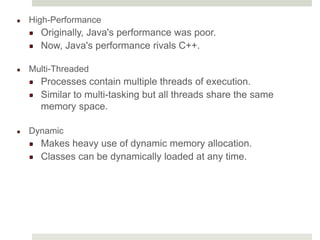Java Class1
- 2. History "Java, whose original name was Oak, was developed as a part of the Green project at Sun. It was started in December '90 by Patrick Naughton, Mike Sheridan and James Gosling and was chartered to spend time trying to figure out what would be the "next wave" of computing and how we might catch it. They came to the conclusion that at least one of the waves was going to be the convergence of digitally controlled consumer devices and computers. " Applets and Applications "The team returned to work up a Java technology-based clone of Mosaic they named "WebRunner" (after the movie Blade Runner), later to become officially known as the HotJavaTM browser. It was 1994. WebRunner was just a demo, but an impressive one: It brought to life, for the first time, animated, moving objects and dynamic executable content inside a Web browser. That had never been done. [At the TED conference.]"
- 3. What is Java Java - The new programming language from Sun Microsystems Java -Allows anyone to publish a web page with Java code in it Java - CPU Independent language Created for consumer electronics Java - James , Arthur Van , and others
- 4. What is Java It is an object-oriented language developed by Sun in the mid 1990s. Original language called Oak Intended for embedded systems • Unlike C++, it was developed from scratch. The syntax is very similar to C. Sun describes it as "A simple, object-oriented, distributed, interpreted, robust, secure, architecture neutral, portable, high-performance, multi-threaded and dynamic language."
- 5. Object-Oriented Designed to support Object-Oriented concepts Distributed Applications are constructed using objects. Objects can be distributed in multiple locations within a network environment. Extensive integration with TCP/IP Interpreted Java compiles to byte-code (not machine code). Byte code is interpreted. Most Java versions after 1.2 include a JIT (Just-In-Time) compiler which compiles byte code to machine code.
- 6. Robust Memory management is done automatically Use of pointers is limited Secure All Java code subject to security model. Architecture-Neutral/Portable Compiled Java (byte code) will run on any platform which has a Java Virtual Machine The Java Virtual Machine is available for almost all platforms... Even mainframes.
- 7. High-Performance Originally, Java's performance was poor. Now, Java's performance rivals C++. Multi-Threaded Processes contain multiple threads of execution. Similar to multi-tasking but all threads share the same memory space. Dynamic Makes heavy use of dynamic memory allocation. Classes can be dynamically loaded at any time.
- 8. For World Java is : Snazzy Web pages The cross-platform language we want The C++ replacement we need The C++ replacement we dont need A bunch of hype
- 9. For SUN Java is: Simple and Powerful Object Oriented Portable Architecture Neutral Distributed Multi-threaded Robust, Secure/Safe Interpreted High Performance Dynamic pogramming language/platform.
- 10. For Us Java is : Simple Pure Portable Surprisingly effective Need of Today!!!!
- 11. Platform Independence Platform ? Independence???????? Java has been described as WORA (Write once, Run Anywhere) In most cases, this is true. Not always true with GUI. Doesn't always come for free. Can require a lot of testing.
- 12. Platform Independence…. Traditional view : Source.cpp i386 binary SPARC binary PPC binary Windows Compiler Solaris Compiler Mac Compiler
- 13. JVM(Java Virtual Machine) Java source files (.java) are compiled to Java bytecode (.class) Bytecode is interpreted on the target platform within a Java Virtual Machine Source.java i386 VM SPARC VM PPC VM Java Compiler Java Bytecode Source.class
- 14. Why Virtual
- 15. JVM JVM is sometimes referred to as interpreter which takes the byte code from Java Compiler (.Class) and generates the object code for the target machine. The output of Java Compiler is not for a particular existing machine, it is generated for JVM which is actually not a machine therefore it is called Virtual Machine though it is a translator/interpreter which converts one code (byte code) to another code(machine code)
- 16. Independence Because Java source code is compiled to byte code and the byte code is interpreted, Java code can be executed anywhere an interpreter is available. The "Interpreter" is call the Java Virtual Machine
- 18. JVM The Java VM does more than interpret bytecode: The class loader loads appropriate java classes. Possibly from the network. All classes are verified to contain only legal bytecodes and not permitted any illegal stack or register usage. A SecurityManager can limit access to resources such as the local file system or the network. Any unreferenced memory (Objects) are returned to the system by the Garbage Collector thread. • Many database servers, application servers, web servers and browsers contain a Java virtual machine • eg: Oracle, Tomcat (web server), WebSphere (app server), BEA Weblogic (app server), and Netscape and IE.
- 19. Java Integrates Power of Compiled Languages and Flexibility of Interpreted Languages


![History
"Java, whose original name was Oak, was developed as a part of
the Green project at Sun. It was started in December '90 by Patrick
Naughton, Mike Sheridan and James Gosling and was chartered to
spend time trying to figure out what would be the "next wave" of
computing and how we might catch it. They came to the conclusion
that at least one of the waves was going to be the convergence of
digitally controlled consumer devices and computers. "
Applets and Applications
"The team returned to work up a Java technology-based clone of
Mosaic they named "WebRunner" (after the movie Blade Runner),
later to become officially known as the HotJavaTM browser. It was
1994. WebRunner was just a demo, but an impressive one: It
brought to life, for the first time, animated, moving objects and
dynamic executable content inside a Web browser. That had never
been done. [At the TED conference.]"](https://image.slidesharecdn.com/class1-160215070316/85/Java-Class1-2-320.jpg)
















